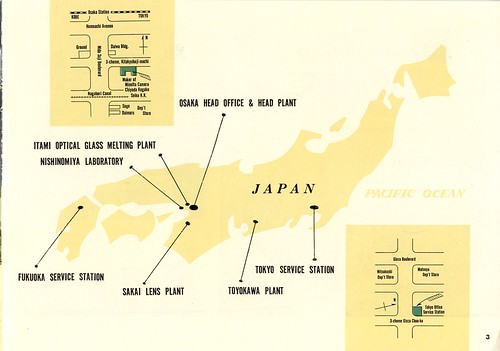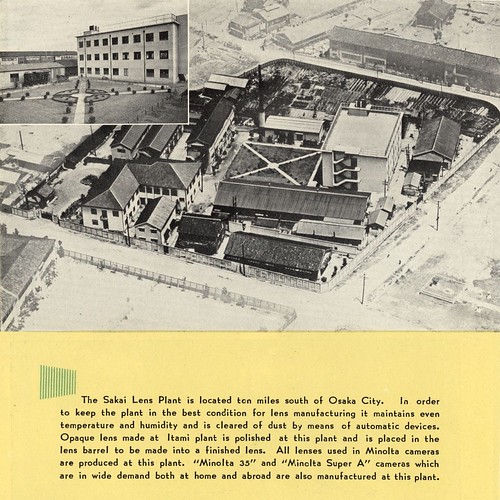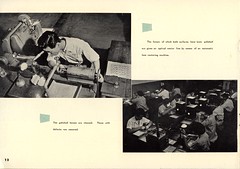Minolta plants
The company Minolta and its predecessors operated various plants in Japan.

|
| Map of the various Minolta plants, c.1957. (Image rights) |
Mukogawa
The original Mukogawa plant was built in 1928–9, when the company was founded as Nichidoku Shashinki Shōten. It was located near the Mukogawa river (武庫川), in the village of Naruo (鳴尾村), in the Muko district (武庫郡) of the Hyōgo prefecture (兵庫県).[1] The plant certainly hosted the headquarters of the company until 1945. All the early folding cameras were produced there, from the Nifcarette to the Semi Minolta, Auto Semi Minolta and Auto Press Minolta.[2] During the war, the factory worked for the Japanese Army, making fuses, shutters for aerial cameras and the aerial camera Type 100.[3] It was eventually destroyed by an air raid in 1945.[4]
Amagasaki
The second plant originated in 1936 as the subsidiary Nippon Kōgaku Kikai Kenkyūjo (日本光学機械研究所, meaning Japanese Opto-mechanical Research Institute).[5] It was located in the city of Amagasaki (尼崎市), in the Hyōgo prefecture, and was soon integrated as the Amagasaki plant.[6] The Minolta Vest, Minolta Six and Baby Minolta bakelite cameras were manufactured there, as well as the TLR Minoltaflex (I) and Minoltaflex Automat. The factory made the Type 1 gun camera for the Army during the war;[7] it too was destroyed by an air raid.[8]
Sakai

|
| Sakai lens plant, c.1957. (Image rights) |
The third Sakai plant was opened in February 1937 in the city of Sakai (堺市), in the Ōsaka prefecture (大阪府), to the south of Osaka City.[9] It is said that it was edified to make camera lenses;[10] the first lenses assembled there were perhaps the Minolta Anastigmat viewing lenses of the TLR models. During the war, the factory worked for the Japanese Navy, and made optical elements such as 7×50 binoculars, 8-inch and 12-inch tele-binoculars, fire sights or azimuth mirrors.[11] It certainly also made the first Rokkor lenses for military use. Unlike the other two original sites, the Sakai plant survived the war; however documents dated 1937 and 1957 show very different installations, and the buildings were perhaps radically transformed. All the Rokkor lenses made were assembled there, at least until the late 1950s.
 
|
 
|
| Lens making process in the Sakai plant, c.1957. (Image rights) |
Komatsu
The Komatsu plant was opened in 1939 in Komatsu (小松), to the west of the Mukogawa plant.[12] It was specialized in making machine tools;[13] it also made the Type 100 fire sight for the Japanese Army.[14] The Komatsu plant was the third Minolta plant destroyed by an air raid in 1945.[15]
To be continued.
Notes
- ↑ Naruo village: "Minolta: There's a Reason", p.2. Muko district, Hyōgo prefecture: Awano, p.6 of Kurashikku Kamera Senka no.12.
- ↑ This is confirmed by Awano, p.7 of Kurashikku Kamera Senka no.12, for the Semi Minolta, Auto Semi Minolta and Auto Press Minolta. This is also obvious for the models released before the edification of the second plant at Amagasaki in 1936.
- ↑ Awano, p.7 of Kurashikku Kamera Senka no.12.
- ↑ "Minolta: There's a Reason", p.2; Awano, p.7 of Kurashikku Kamera Senka no.12.
- ↑ Awano, p.7 of Kurashikku Kamera Senka no.12. Date confirmed in "Minolta: There's a Reason", p.2.
- ↑ Awano, p.7 of Kurashikku Kamera Senka no.12.
- ↑ Awano, p.7 of Kurashikku Kamera Senka no.12.
- ↑ "Minolta: There's a Reason", p.2; Awano, p.7 of Kurashikku Kamera Senka no.12.
- ↑ "Minolta: There's a Reason", p.2; Awano, p.7 of Kurashikku Kamera Senka no.12.
- ↑ "Minolta: There's a Reason", p.2.
- ↑ Awano, p.7 of Kurashikku Kamera Senka no.12.
- ↑ "Minolta: There's a Reason", p.2.
- ↑ Francesch, p.26.
- ↑ Awano, p.7 of Kurashikku Kamera Senka no.12.
- ↑ "Minolta: There's a Reason", p.2; Awano, p.7 of Kurashikku Kamera Senka no.12.
Bibliography
- Awano Mikio (粟野幹男). "Minoruta ryakushi" (ミノルタ略史, Minolta short history). Kamera Rebyū: Kurashikku Kamera Senka (カメラレビュー クラシックカメラ専科) / Camera Review: All about Historical Cameras no.12, October 1988. No ISBN number. Minoruta kamera no subete (ミノルタカメラのすべて, special issue on Minolta). Pp.6–8.
- Chiyoda Kōgaku Seikō (predecessor of Minolta). "Minolta: There's a Reason". Brochure in English language dating c.1957. Document scanned by A. Apra and reproduced in this Flickr album by Rebollo_fr.